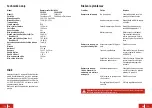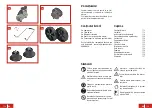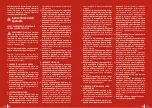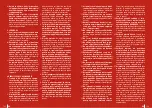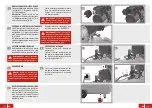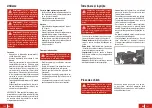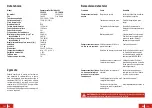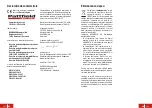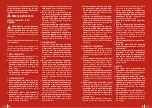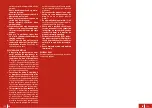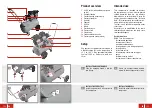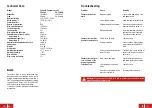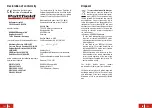
EN
148
EN
149
The compressor is called power tool in these
safety instructions. Nevertheless the com-
pressor is meant and you must definitely fol-
low these safety instructions.
Safety Instructions
GENERAL POWER TOOL SAFETY
WARNINGS
WARNING Read all safety warnings,
instructions, illustrations and speci-
fications provided with this power tool.
Failure to follow the warnings and instructions
may result in electric shock, fire and/or seri-
ous injury.
Save all warnings and instructions for fu-
ture reference.
The term “power tool” in the warnings refers
to your mains-operated (corded) power tool o
battery-operated (cordless) power tool.
1 WORK AREA SAFETY
a)
Keep work area clean and well lit.
Clut-
tered or dark areas invite accidents.
b)
Do not operate power tools in explosive
atmospheres, such as in the presence of
flammable liquids, gases or dust.
Power
tools create sparks which may ignite the
dust or fumes.
c)
Keep children and bystanders away
while operating a power tool.
Distractions
can cause you to lose control.
2 ELECTRICAL SAFETY
a)
Power tool plugs must match the outlet.
Never modify the plug in any way. Do
not use any adapter plugs with earthed
(grounded) power tools.
Unmodified plugs
and matching outlets will reduce risk of
electric shock.
b)
Avoid body contact with earthed or
grounded surfaces, such as pipes, ra-
diators, ranges and refrigerators.
There
is an increased risk of electric shock if your
body is earthed or grounded.
c)
Do not expose power tools to rain or wet
conditions.
Water entering a power tool will
increase the risk of electric shock.
d)
Do not abuse the cord. Never use the
cord for carrying, pulling or unplugging
the power tool. Keep cord away from
heat, oil, sharp edges or moving parts.
Damaged or entangled cords increase the
risk of electric shock.
e)
When operating a power tool outdoors,
use an extension cord suitable for out-
door use.
Use of a cord suitable for outdoor
use reduces the risk of electric shock.
f)
If operating a power tool in a damp loca-
tion is unavoidable, use a residual cur-
rent device (RCD) protected supply.
Use
of an RCD reduces the risk of electric shock.
3 PERSONAL SAFETY
a)
Stay alert, watch what you are doing
and use common sense when operating
a power tool. Do not use a power tool
while you are tired or under the influ-
ence of drugs, alcohol or medication.
A moment of inattention while operating
power tools may result in serious personal
injury.
b)
Use personal protective equipment.
Always wear eye protection with side
shields, along with hearing protection.
Failure to do so could result in objects be-
ing thrown into your eyes and other pos-
sible serious injuries. Protective equipment
such as dust mask, non-skid safety shoes,
hard hat, or hearing protection used for ap-
propriate conditions will reduce personal
injuries.
c)
Prevent unintentional starting. Ensure
the switch is in the off-position before
connecting to power source and/or bat-
tery pack, picking up or carrying the
tool.
Carrying power tools with your finger
on the switch or energising power tools that
have the switch on invites accidents.
d)
Do not overreach. Keep proper footing
and balance at all times.
This enables
better control of the power tool in unex-
pected situations.
e)
Dress properly. Do not wear loose cloth-
ing or jewellery. Keep your hair, cloth-
ing and gloves away from moving parts.
Loose clothes, jewellery or long hair can be
caught in moving parts.
f)
If devices are provided for the connec-
tion of dust extraction and collection fa-
cilities, ensure these are connected and
properly used.
Use of dust collection can
reduce dust-related hazards.
g)
Do not let familiarity gained from fre-
quent use of tools allow you to become
complacent and ignore tool safety prin-
ciples.
A careless action can cause severe
injury within a fraction of a second.
h)
Do not use on a ladder or unstable sup-
port.
Stable footing on a solid surface ena-
bles better control of the tool in unexpected
situations.
4 POWER TOOL USE AND CARE
a)
Do not exceed the pressure rating of
any component in the system.
All hoses
and fittings must be suitable for use at the
maximum allowable pressure of the com-
pressor.
b)
Protect material lines and air lines from
damage or puncture.
Keep hose and pow-
er cord away from sharp objects, chemical
spills, oil, solvents, and wet floors. Hoses
must be fitted with a safety wire for operat-
ing pressures above 7 bars.
c)
Check hoses for weak or worn condition
before each use, making certain all con-
nections are secure.
Do not use if defect
is found. Purchase a new hose or notify an
authorized service centre for examination
or repair.
d)
Release all pressures within the system
slowly.
Dust and debris may be harmful.
e)
Store idle power tools out of the reach
of children and do not allow persons
unfamiliar with the power tool or these
instructions to operate the power tool.
Power tools are dangerous in the hands of
untrained users.
f)
Maintain tools with care.
Follow main-
tenance instructions. Properly maintained
tools are easier to control. Many accidents
are caused by poorly maintained tools.
g)
Check for misalignment or binding of
moving parts, breakage of parts, and
any other condition that may affect the
operation of the tool.
If damaged, have
the tool repaired before using.
h)
Never point any tool toward yourself or
others.
i)
Keep the exterior of the air compressor
dry, clean, and free from oil and grease.
Always use a clean cloth when cleaning.
Never use brake fluids, gasoline, petrole-
um-based products, or any strong solvents
to clean the unit. Following this rule will
reduce the risk of deterioration of the en-
closure plastic.
j)
Ensure compatibility of accessories be-
fore using.
k)
Read and understand the operating
manual for any accessories or air tools
before using.
l)
Use the power tool and accessories in
accordance with these instructions,
taking into account the working condi-
tions and the work to be performed.
Use
of the power tool for operations different
from those intended could result in a haz-
ardous situation.
5 SERVICE
a)
Tool service must be performed only
by qualified repair personnel.
Service or
maintenance performed by unqualified per-
sonnel may result in a risk of injury.
b)
Disconnect power supply, open conden-
sation drain valve to decompress tank
and allow water to drain, and allow air
compressor to become cool to the touch
before servicing.
Turn pressure regulator
knob fully counterclockwise after shutting
off compressor.
c)
When servicing, use only identical re-
placement parts.
Follow instructions in
the Maintenance section of this manual.
Use of unauthorized parts or failure to fol-
low Maintenance instructions may create a
risk of injury.



